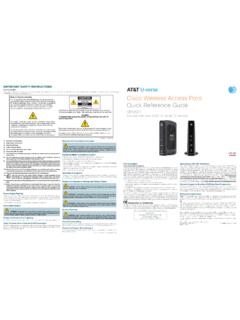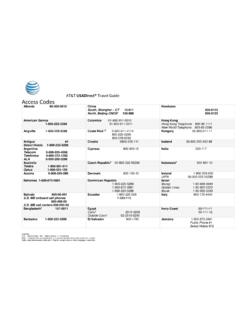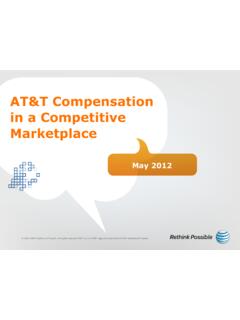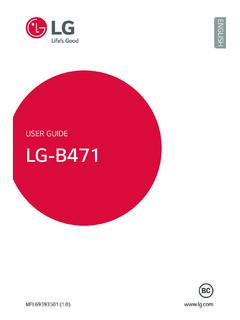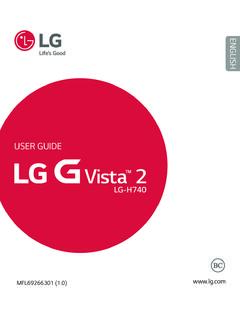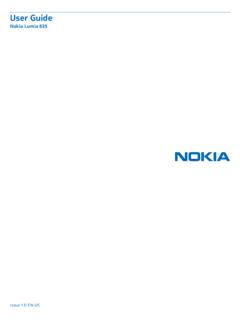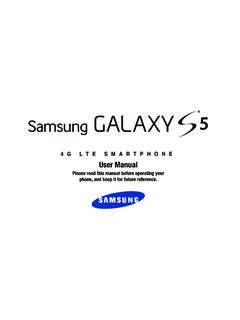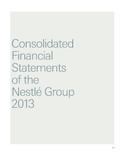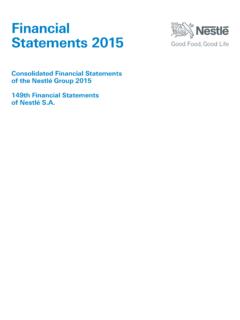Transcription of Notes to Consolidated Financial Statements
1 64 AT&T 09 ARNotes to Consolidated Financial StatementsDollars in millions except per share amountsNoncontrolling Interests Reporting In December 2007, the FASB issued a standard that requires noncontrolling interests held by parties other than the parent in subsidiaries to be clearly identified, labeled, and presented in the Consolidated balance sheets within stockholders equity, but separate from the parent s equity. For us, the new standard became effective January 1, 2009, with restatement of prior Financial Statements . Instead of including noncontrolling interest in Other income (expense) net in our Consolidated Statements of income, we disclose three measures of net income: net income, net income attributable to noncontrolling interest, and net income attributable to AT&T, and our operating cash flows in our Consolidated Statements of cash flows reflect net income.
2 Furthermore, we continue to base our basic and diluted earnings per share calculations on net income attributable to AT& January 2010, the FASB issued guidance that amends accounting and disclosure requirements for a decrease in ownership in a business under existing GAAP standards for consolidations. It also clarifies the types of businesses that are in the scope of these consolidations. As required by this guidance, we retroactively applied the amendments as of January 1, 2009, which did not have a material impact on our Financial Statements or footnote Value Measurements and Disclosures In April 2009, the FASB issued staff positions that require enhanced disclosures, including interim disclosures, on Financial instruments, determination of fair value in turbulent markets, and recognition and presentation of other-than-temporary impairments.
3 These staff positions were effective for interim and annual reporting periods beginning in our second quarter of 2009. They increased our interim disclosures but have not had a material impact on our Financial position or results of August 2009, the FASB issued Measuring Liabilities at Fair Value (ASU 2009-05), which amends existing GAAP for fair value measurement guidance by clarifying the fair value measurement requirements for liabilities that lack a quoted price in an active market. Per the Codification, a valuation technique based on a quoted market price for the identical or similar liability when traded as an asset or another valuation technique ( , an income or market approach) that is consistent with the underlying principles of GAAP for fair value measurements would be appropriate.
4 ASU 2009-05 also clarifies that a reporting entity is not required to add or adjust valuation inputs to compensate for transfer restrictions on in-scope liabilities. ASU 2009-05 was effective August 2009, the issuance date, and has not had a material impact on our Financial position or results of September 2009, the FASB issued Investments in Certain Entities That Calculate Net Asset Value per Share (or Its Equivalent) (ASU 2009-12), which provides guidance for an investor on using the net asset value per share provided by an investee to estimate the fair value of an alternative investment when the fair value for the primary investment is not readily determinable. It affects certain NOTE 1.
5 SUMMARY OF SIGNIFICANT ACCOUNTING POLICIESB asis of Presentation Throughout this document, AT&T Inc. is referred to as AT&T, we or the Company. The Consolidated Financial Statements have been prepared pursuant to Regulation S-X and other applicable rules of the Securities and Exchange Commission. The Consolidated Financial Statements include the accounts of the Company and our majority-owned subsidiaries and affiliates. Our subsidiaries and affiliates operate in the communications services industry both domestically and internationally, providing wireless and wireline communications services and equipment, managed networking, wholesale services, and advertising significant intercompany transactions are eliminated in the consolidation process.
6 Investments in partnerships and less-than-majority-owned subsidiaries where we have significant influence are accounted for under the equity method. Earnings from certain foreign equity investments accounted for using the equity method are included for periods ended within up to one month of our year-end (see Note 7).The preparation of Financial Statements in conformity with generally accepted accounting principles (GAAP) requires management to make estimates and assumptions that affect the amounts reported in the Financial Statements and accompanying Notes , including estimates of probable losses and expenses. Actual results could differ from those estimates. We have reclassified certain amounts in prior-period Financial Statements to conform to the current period s Accounting StandardsAccounting Standards Codification In June 2009, the Financial Accounting Standards Board (FASB) issued standards that established the FASB Accounting Standards Codification (ASC or Codification) as the source of authoritative GAAP by the FASB for nongovernmental entities.
7 The ASC supersedes all non-SEC accounting and reporting standards that existed at the ASC s effective date. The FASB uses Accounting Standards Updates (ASU) to amend the ASC. We refer to ASUs throughout our interim and annual reports where deemed relevant and make general references to pre- Codification standards ( , GAAP standards for acquisitions). These standards were effective for interim and annual periods ending after September 15, 2009 ( , the quarterly period ended September 30, 2009, for us).Subsequent Events In May 2009, the FASB issued a standard that established general standards of accounting for and disclosing events that occur after the balance sheet date but before Financial Statements are issued or are available for issuance.
8 They were effective for interim and annual periods ending after June 15, 2009 ( , the quarterly period ended June 30, 2009, for us). In preparing the accompanying audited Consolidated Financial Statements , we have reviewed all known events that have occurred after December 31, 2009, and through February 25, 2010, the filing date of our Annual Report on Form 10-K, for inclusion in the Financial Statements and 22/24/10 7:43 PMAT&T 09 AR 65disclosures. We adopted the new guidance for the year ended December 31, 2009. This guidance significantly increased the amount of annual disclosures for plan assets in our annual report, and it will increase our future interim disclosures in that regard (see Note 11).
9 Business Combinations In December 2007, the FASB amended GAAP for acquisitions, requiring that costs incurred to effect the acquisition ( , acquisition-related costs) be recognized separately from the acquisition. Under prior guidance, restructuring costs that the acquirer expected but was not obligated to incur, which included changes to benefit plans, were recognized as if they were a liability assumed at the acquisition date. Amended GAAP for acquisitions requires the acquirer to recognize those costs separately from the business combination. We adopted the new guidance as of January 1, 2009, and applied it to acquisitions consummated after 2008, including the Centennial Communications, Corp.
10 (Centennial) acquisition, as discussed in Note Method Investments Accounting In November 2008, the Emerging Issues Task Force (EITF) reached a consensus on new clarification guidance regarding the application of the equity method. It states equity method investments should be recognized using a cost accumulation model. It also requires that equity method investments as a whole be assessed for other-than-temporary impairment in accordance with existing GAAP for equity method investments. The new guidance was effective, on a prospective basis, for initial or additional equity method investments transactions and subsequent impairments recognized in interim and annual periods that began on or after December 15, 2008 ( , as of January 1, 2009, for us).
